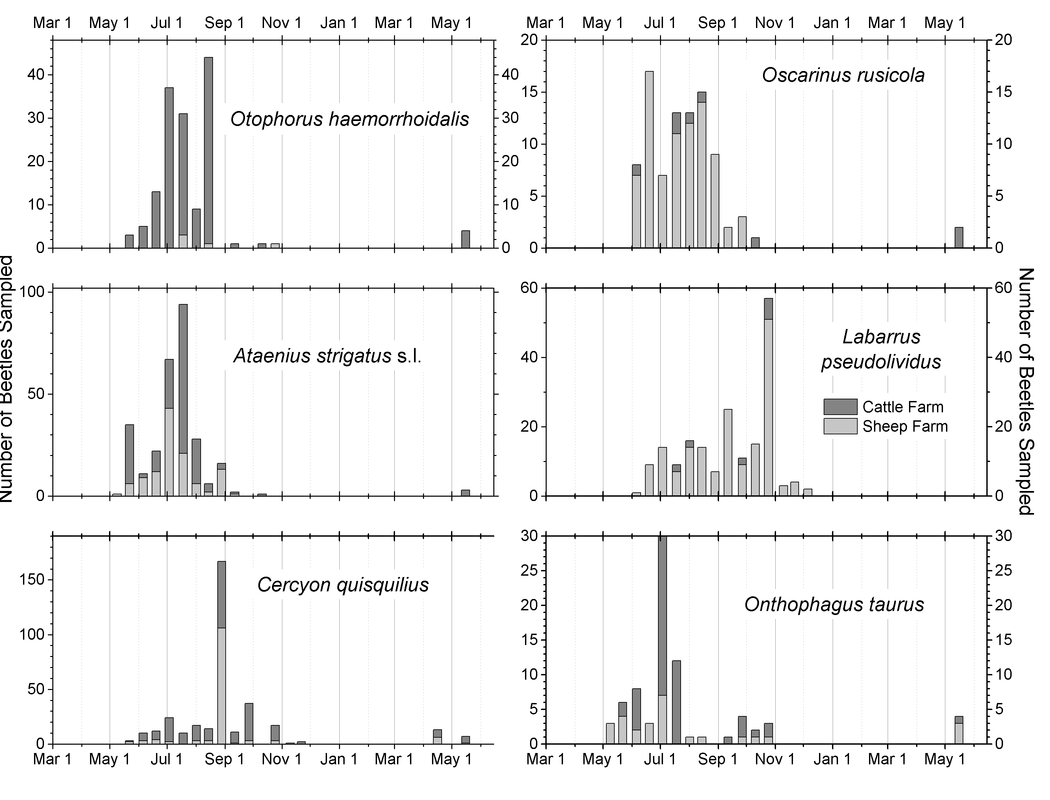Ecology of Coprophilous Beetles
Between June 2017 and May 2018, I investigated the seasonality (phenology) and succession of coprophilous beetles on the only remaining pasture within 3 miles of the City of Adrian on the Carpenter Farm. I setup 15 pitfall traps baited with fresh cattle manure and collected beetles after 48 hours and again after 96 hours every other week. Despite the severe winter of 2017/2018 with temperatures going down to -2 F, I continued sampling throughout the winter. I am currently working on a first draft of this paper.
A total of 17 species of Scarabaeidae (1,288 individuals) and nine species of Hydrophilidae (482 individuals) were
sampled from a cattle and sheep farm in southeastern Michigan between March 2012 and May 2013. Seven of these
species are native, while 19 species are of European origin. Despite the closeness of the farms (730 m), Otophorus
haemorrhoidalis (L.), Sphaeridium lunatum F., and Sphaeridium scarabaeoides (L.) were found significantly more
frequently on the cattle farm, whereas Labarrus pseudolividus (Balthasar), Oscarinus rusicola (Melsheimer), and
Blackburneus stercorosus (Melsheimer) were found significantly more frequently on the sheep farm. The highest abundances
of beetles were encountered between May and November and correlated with temperatures above 10°C. Eleven
species occurred only from spring to summer, eight species occurred from summer until autumn, and six species
showed a split pattern of spring to early summer, absence during summer, and a second occurrence in autumn. No
beetles were found between 4 January and 16 April 2013. To further understand the invasive potential of adventive
dung beetle species, seasonal patterns of species within the three groups were compared to seasonal patterns of the
same species at more northern, more southern, and European locations and to predictions arising from climatic differences
between these latitudes.
sampled from a cattle and sheep farm in southeastern Michigan between March 2012 and May 2013. Seven of these
species are native, while 19 species are of European origin. Despite the closeness of the farms (730 m), Otophorus
haemorrhoidalis (L.), Sphaeridium lunatum F., and Sphaeridium scarabaeoides (L.) were found significantly more
frequently on the cattle farm, whereas Labarrus pseudolividus (Balthasar), Oscarinus rusicola (Melsheimer), and
Blackburneus stercorosus (Melsheimer) were found significantly more frequently on the sheep farm. The highest abundances
of beetles were encountered between May and November and correlated with temperatures above 10°C. Eleven
species occurred only from spring to summer, eight species occurred from summer until autumn, and six species
showed a split pattern of spring to early summer, absence during summer, and a second occurrence in autumn. No
beetles were found between 4 January and 16 April 2013. To further understand the invasive potential of adventive
dung beetle species, seasonal patterns of species within the three groups were compared to seasonal patterns of the
same species at more northern, more southern, and European locations and to predictions arising from climatic differences
between these latitudes.
Fig. 2: Dung beetle phenology - Species that occur from summer until (late) autumn. Stacked bars show total beetle count in a bimonthly sample with bright portions showing beetles sampled from the sheep farm, and dark portions beetles sampled from the cattle farm.








